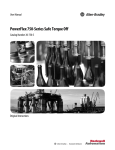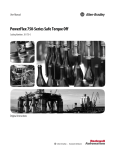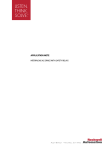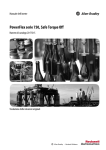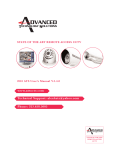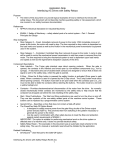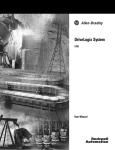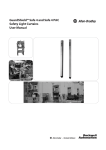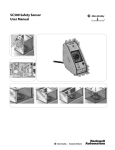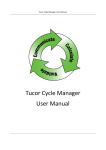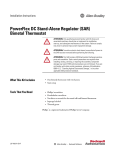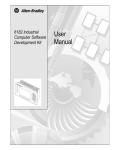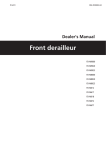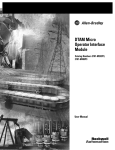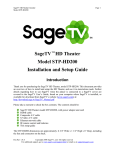Download PowerFlex® 750-Series Safe Torque Off
Transcript
User Manual PowerFlex® 750-Series Safe Torque Off Catalog Number 20-750-S Important User Information Solid-state equipment has operational characteristics differing from those of electromechanical equipment. Safety Guidelines for the Application, Installation and Maintenance of Solid State Controls (publication SGI-1.1 available from your local Rockwell Automation sales office or online at http://www.rockwellautomation.com/literature/) describes some important differences between solid-state equipment and hard-wired electromechanical devices. Because of this difference, and also because of the wide variety of uses for solid-state equipment, all persons responsible for applying this equipment must satisfy themselves that each intended application of this equipment is acceptable. In no event will Rockwell Automation, Inc. be responsible or liable for indirect or consequential damages resulting from the use or application of this equipment. The examples and diagrams in this manual are included solely for illustrative purposes. Because of the many variables and requirements associated with any particular installation, Rockwell Automation, Inc. cannot assume responsibility or liability for actual use based on the examples and diagrams. No patent liability is assumed by Rockwell Automation, Inc. with respect to use of information, circuits, equipment, or software described in this manual. Reproduction of the contents of this manual, in whole or in part, without written permission of Rockwell Automation, Inc., is prohibited. Throughout this manual, when necessary, we use notes to make you aware of safety considerations. WARNING: Identifies information about practices or circumstances that can cause an explosion in a hazardous environment, which may lead to personal injury or death, property damage, or economic loss. ATTENTION: Identifies information about practices or circumstances that can lead to personal injury or death, property damage, or economic loss. Attentions help you identify a hazard, avoid a hazard, and recognize the consequence SHOCK HAZARD: Labels may be on or inside the equipment, for example, a drive or motor, to alert people that dangerous voltage may be present. BURN HAZARD: Labels may be on or inside the equipment, for example, a drive or motor, to alert people that surfaces may reach dangerous temperatures. IMPORTANT Identifies information that is critical for successful application and understanding of the product. Allen-Bradley, Rockwell Software, Rockwell Automation, and TechConnect are trademarks of Rockwell Automation, Inc. Trademarks not belonging to Rockwell Automation are property of their respective companies. Summary of Changes This manual contains new and updated information. New and Updated Information This table contains the changes made to this revision. Topic Page PowerFlex Frame 8 drive information added. Throughout PFD and PFH for 20-year Proof Test Interval table updated. 7 Details on hardware enable jumper added. 20 Port 6 installation requirement for Integrated Motion applications added to Important statement. 22 Tip added explaning how module operation is verified. 24 Required jumper settings added to connection examples. 27…29 Rockwell Automation Publication 750-UM002C-EN-P - December 2010 3 Summary of Changes 4 Rockwell Automation Publication 750-UM002C-EN-P - December 2010 Table of Contents Chapter 1 General Description What Is the PowerFlex 750-Series Safe Torque Off Option? . . . . . . . . . . 7 Safety of Machinery Standards. . . . . . . . . . . . . . . . . . . . . . . . . . . . . . . . . . . . . . 8 Evaluation/Certification by TÜV Rheinland Group . . . . . . . . . . . . . . . . . 8 Chapter 2 Safety Concept Introduction . . . . . . . . . . . . . . . . . . . . . . . . . . . . . . . . . . . . . . . . . . . . . . . . . . . . . . 9 Safety Certification . . . . . . . . . . . . . . . . . . . . . . . . . . . . . . . . . . . . . . . . . . . . . . . . 9 Functional Proof Tests. . . . . . . . . . . . . . . . . . . . . . . . . . . . . . . . . . . . . . . . . . . . 11 PFD and PFH Definitions . . . . . . . . . . . . . . . . . . . . . . . . . . . . . . . . . . . . . . . . 11 PFD and PFH Data . . . . . . . . . . . . . . . . . . . . . . . . . . . . . . . . . . . . . . . . . . . . . . 12 Safe State . . . . . . . . . . . . . . . . . . . . . . . . . . . . . . . . . . . . . . . . . . . . . . . . . . . . . . . . 12 Safety Reaction Time . . . . . . . . . . . . . . . . . . . . . . . . . . . . . . . . . . . . . . . . . . . . . 12 Considerations for Safety Ratings . . . . . . . . . . . . . . . . . . . . . . . . . . . . . . . . . . 13 Contact Information if Safety Option Failure Occurs . . . . . . . . . . . . . . . 13 Chapter 3 Installation and Wiring Access Drive Control Pod. . . . . . . . . . . . . . . . . . . . . . . . . . . . . . . . . . . . . . . . . Configure Safety Enable . . . . . . . . . . . . . . . . . . . . . . . . . . . . . . . . . . . . . . . . . . Option Module Installation . . . . . . . . . . . . . . . . . . . . . . . . . . . . . . . . . . . . . . . Wiring . . . . . . . . . . . . . . . . . . . . . . . . . . . . . . . . . . . . . . . . . . . . . . . . . . . . . . . . . . Verify Operation . . . . . . . . . . . . . . . . . . . . . . . . . . . . . . . . . . . . . . . . . . . . . . . . . 16 19 22 23 24 Chapter 4 Description of Operation PowerFlex 750-Series Safe Torque Off Operation . . . . . . . . . . . . . . . . . . . 25 Appendix A Specifications Introduction . . . . . . . . . . . . . . . . . . . . . . . . . . . . . . . . . . . . . . . . . . . . . . . . . . . . . 31 General Specifications . . . . . . . . . . . . . . . . . . . . . . . . . . . . . . . . . . . . . . . . . . . . 31 Certifications . . . . . . . . . . . . . . . . . . . . . . . . . . . . . . . . . . . . . . . . . . . . . . . . . . . . 31 Rockwell Automation Publication 750-UM002C-EN-P - December 2010 5 Table of Contents 6 Rockwell Automation Publication 750-UM002C-EN-P - December 2010 Chapter 1 General Description The Safe Torque Off option is just one component in a safety control system. Components in the system must be chosen and applied appropriately to achieve the desired level of operational safety. What Is the PowerFlex 750-Series Safe Torque Off Option? The PowerFlex 750-Series Safe Torque Off option: • Is designed to help safely remove power from the gate firing circuits of the drive’s output power devices (IGBT’s). This helps prevent the drive’s output power devices from switching in the pattern necessary to generate AC power to the motor. • Can be used in combination with other safety devices to satisfy the requirements of IEC 61508, IEC 61800-5-2 SIL 3, ISO 13849-1 PLe, and Category 3 (EN 954-1) for Safe Torque Off (STO). IMPORTANT This option is suitable for performing mechanical work on the drive system or affected area of a machine only. It does not provide electrical safety. This option should not be used as a control for starting and/or stopping the drive. ATTENTION: Electrical Shock Hazard. Verify that all sources of AC and DC power are deenergized and locked out or tagged out in accordance with the requirements of ANSI/NFPA 70E, Part II. ATTENTION: To avoid an electric shock hazard, verify that the voltage on the bus capacitors has discharged before performing any work on the drive. Measure the DC bus voltage at the +DC and -DC terminals or test points (refer to your drive’s User Manual for locations). The voltage must be zero. ATTENTION: In safe-off mode, hazardous voltages may still be present at the motor. To avoid an electric shock hazard, disconnect power to the motor and verify that the voltage is zero before performing any work on the motor. ATTENTION: In the event of the failure of two output IGBTs in the drive, when the PowerFlex 750-Series Safe Torque Off option has controlled the drive outputs to the off state, the drive may provide energy for up to 180° of rotation in a 2-pole motor before torque production in the motor ceases. Rockwell Automation Publication 750-UM002C-EN-P - December 2010 7 Chapter 1 General Description Safety of Machinery Standards The Safe Torque Off option helps to satisfy requirements in the following standards: • IEC 61508: 2000 SIL 3 • IEC 61800-5-2: 2007 SIL 3 • IEC 61800-3: 2004 • IEC 62061: 2005 • ISO 13849-1: 2006 Performance Level e, Category 3 • EN 954-1: 1996 – Category 3 • IEC 60204-1: 2005 • NFPA 79: 2007 Evaluation/Certification by TÜV Rheinland Group Drive PowerFlex 753 PowerFlex 755 PowerFlex 755 8 Rating TÜV Report on Safety Function TÜV fs Certification 400/480V Frames 2…7 968/EZ 334.00/08 968/EZ 334.00/08 400/480V Frame 8 968/M 262.00/10 968/M 262.00/10 Rockwell Automation Publication 750-UM002C-EN-P - December 2010 Chapter 2 Safety Concept Introduction This section describes the safety performance level concept and how the PowerFlex 750-Series drives can meet the requirements for SIL CL3, CAT 3, or PL(e) applications. Safety Certification The PowerFlex 750-Series safety option is certified for use in safety applications up to and including SIL 3 according to EN 61800-5-2, EN 61508, and EN 62061, Performance Level PL(e) and Category 3 according to ISO 13849-1. Safety requirements are based on the standards current at the time of certification. The TÜV Rheinland group has approved the PowerFlex 750-Series safety option for use in safety-related applications where the de-energized state is considered to be the safe state. All of the examples in this manual are based on achieving de-energization as the safe state for typical Machine Safety and Emergency Shutdown (ESD) systems. Important Safety Considerations The system user is responsible for: • the set-up, safety rating, and validation of any sensors or actuators connected to the system. • completing a system-level risk assessment and reassessing the system any time a change is made. • certification of the system to the desired safety performance level. • project management and proof testing. • programming the application software and the safety option configurations in accordance with the information in this manual. • access control to the system. • analyzing all configuration settings and choosing the proper setting to achieve the required safety rating. IMPORTANT When applying Functional Safety, restrict access to qualified, authorized personnel who are trained and experienced. ATTENTION: When designing your system, consider how personnel will exit the machine if the door locks while they are in the machine. Additional safeguarding devices may be required for your specific application. Rockwell Automation Publication 750-UM002C-EN-P - December 2010 9 Chapter 2 Safety Concept Safety Category 3 Performance Definition To achieve Safety Category 3 according to ISO 13849-1:2006, the safety-related parts have to be designed such that: • the safety-related parts of machine control systems and/or their protective equipment, as well as their components, shall be designed, constructed, selected, assembled, and combined in accordance with relevant standards so that they can withstand expected conditions. • basic safety principles shall be applied. • a single fault in any of its parts does not lead to a loss of safety function. • a single fault is detected at or before the next demand of the safety function, or, if this detection is not possible, then an accumulation of faults shall not lead to a loss of the safety function. • the average diagnostic coverage of the safety-related parts of the control system shall be high, including the accumulation of faults. • the mean time to dangerous failure of each of the redundant channels shall be high. • measures against common cause failure shall be applied. Stop Category Definitions The selection of a stop category for each stop function must be determined by a risk assessment. • Stop Category 0 is achieved with immediate removal of power to the actuator, resulting in an uncontrolled coast to stop. Safe Torque Off accomplishes a Stop Category 0 stop. • Stop Category 1 is achieved with power available to the machine actuators to achieve the stop. Power is removed from the actuators when the stop is achieved. • Stop Category 2 is a controlled stop with power available to the machine actuators. The stop is followed by a holding position under power. IMPORTANT 10 When designing the machine application, timing and distance should be considered for a coast to stop (Stop Category 0 or Safe Torque Off). For more information regarding stop categories, refer to EN 60204-1. Rockwell Automation Publication 750-UM002C-EN-P - December 2010 Safety Concept Chapter 2 Performance Level and Safety Integrity Level (SIL) CL3 For safety-related control systems, Performance Level (PL), according to ISO 13849-1, and SIL levels, according to EN 61508 and EN 62061, include a rating of the system’s ability to perform its safety functions. All of the safety-related components of the control system must be included in both a risk assessment and the determination of the achieved levels. Refer to the ISO 13849-1, EN 61508, and EN 62061 standards for complete information on requirements for PL and SIL determination. Functional Proof Tests The functional safety standards require that functional proof tests be performed on the equipment used in the system. Proof tests are performed at user-defined intervals and are dependent upon PFD and PFH values. IMPORTANT PFD and PFH Definitions Your specific application determines the time frame for the proof test interval. Safety-related systems can be classified as operating in either a Low Demand mode, or in a High Demand/Continuous mode. • Low Demand mode: where the frequency of demands for operation made on a safety-related system is no greater than one per year or no greater than twice the proof-test frequency. • High Demand/Continuous mode: where the frequency of demands for operation made on a safety-related system is greater than once per year or greater than twice the proof test interval. The SIL value for a low demand safety-related system is directly related to order-of-magnitude ranges of its average probability of failure to satisfactorily perform its safety function on demand or, simply, average probability of failure on demand (PFD). The SIL value for a High Demand/continuous mode safety-related system is directly related to the probability of a dangerous failure occurring per hour (PFH). Rockwell Automation Publication 750-UM002C-EN-P - December 2010 11 Chapter 2 Safety Concept PFD and PFH Data PFD and PFH calculations are based on the equations from Part 6 of EN 61508. This table provides data for a 20-year proof test interval and demonstrates the worst-case effect of various configuration changes on the data. PFD and PFH for 20-year Proof Test Interval Attribute Value Drive Frames 2…7 Drive Frame 8 PFD 3.29E-5 3.81E-04 PFH 3.75E-10 4.46E-09 SFF 99.5% 98.4% DC 99.5% (1) 90.0% SIL CL 3 3 PL e e CAT. 3 3 HFT 1 (1oo2) 1 (1oo2) PTI (Proof Test Interval) 20 years 20 years (1) Without connection to external equipment. Safe State The Safe State encompasses all operation that occurs outside of the other monitoring and stopping behavior defined as part of the Safe Torque Off Option module. If a Safe State Fault is detected, the safety option goes to the Safe State. This includes faults related to integrity of hardware or firmware. Safety Reaction Time The safety reaction time is the amount of time from a safety-related event as input to the system until the system is in the Safe State. The safety reaction time from an input signal condition that triggers a safe stop, to the initiation of the configured Stop Type, is: • 20 ms (maximum) for drive Frames 2…7 • 20.8 ms (maximum) for drive Frame 8 12 Rockwell Automation Publication 750-UM002C-EN-P - December 2010 Safety Concept Considerations for Safety Ratings Chapter 2 The achievable safety rating of an application using the safety option installed in PowerFlex 750-Series drives is dependent upon many factors, drive options, and the type of motor. For applications that rely on the immediate removal of power to the actuator, resulting in an uncontrolled coast to stop, a safety rating up to and including SIL CL3, PL(e), and Category 3 can be achieved. Contact Information if Safety Option Failure Occurs If you experience a failure with any safety-certified device, contact your local Rockwell Automation distributor. With this contact, you can: • return the device to Rockwell Automation so the failure is appropriately logged for the catalog number affected and a record is made of the failure. • request a failure analysis (if necessary) to determine the probable cause of the failure. Rockwell Automation Publication 750-UM002C-EN-P - December 2010 13 Chapter 2 Safety Concept Notes: 14 Rockwell Automation Publication 750-UM002C-EN-P - December 2010 Chapter 3 Installation and Wiring Installation must be in accordance with the following steps and must be carried out by competent personnel. The Safe Torque Off option is intended to be part of the safety related control system of a machine. Before installation, a risk assessment should be performed that compares the Safe Torque Off option specifications and all foreseeable operational and environmental characteristics of the machine to which it is to be fitted. A safety analysis of the machine section controlled by the drive is required to determine how often the safety function should be tested for proper operation during the life of the machine. ATTENTION: The following information is merely a guide for proper installation. Rockwell Automation, Inc. cannot assume responsibility for the compliance or the noncompliance to any code, national, local or otherwise for the proper installation of this equipment. A hazard of personal injury and/or equipment damage exists if codes are ignored during installation. Rockwell Automation Publication 750-UM002C-EN-P - December 2010 15 Chapter 3 Installation and Wiring Access Drive Control Pod 1. Remove drive cover. Frames 2…5. – Squeeze locking tabs and pull out bottom of cover. – Pull cover down and away from the chassis Frames 6…7 – Loosen door screws. – Gently pry the door open to remove. 16 Rockwell Automation Publication 750-UM002C-EN-P - December 2010 Installation and Wiring Chapter 3 Frame 8 – Remove top screws. – Loosen bottom screws. Rockwell Automation Publication 750-UM002C-EN-P - December 2010 17 Chapter 3 Installation and Wiring 2. Lift the Human Interface Module (HIM) cradle (All Frames). Frames 2…7 Frame 8 – Loosen the retention screw. – Lift the cradle until the latch engages. 18 Rockwell Automation Publication 750-UM002C-EN-P - December 2010 Installation and Wiring Configure Safety Enable Chapter 3 Safety Enable Jumper When installing the Safe Torque Off option module, ensure the safety enable jumper (SAFETY) on the Main Control Board is removed. Figure 1 - PowerFlex 753 - SAFETY Jumper Location Figure 2 - PowerFlex 755 - SAFETY Jumper Location (Frames 2…7 Only) Note: Frame 8 drives do not have a safety enable jumper. Rockwell Automation Publication 750-UM002C-EN-P - December 2010 19 Chapter 3 Installation and Wiring Hardware Enable Jumper When installing the Safe Torque Off option module, ensure the hardware enable jumper (ENABLE) on the Main Control Board is installed. PowerFlex 753 - ENABLE Jumper Location PowerFlex 755 - ENABLE Jumper Location (Frames 2…7) 20 Rockwell Automation Publication 750-UM002C-EN-P - December 2010 Installation and Wiring Chapter 3 PowerFlex 755 - ENABLE Jumper Location (Frame 8) Rockwell Automation Publication 750-UM002C-EN-P - December 2010 21 Chapter 3 Installation and Wiring Option Module Installation ATTENTION: Hazard of equipment damage exists if an option module is installed or removed while the drive is powered. To avoid damaging the drive, verify that the voltage on the bus capacitors has discharged before performing any work on the drive. Frames 2…7: Measure the DC bus voltage at the Power Terminal Block by measuring between the +DC and -DC terminals, between the +DC terminal and the chassis, and between the -DC terminal and the chassis. The voltage must be zero for all three measurements. Frame 8: Measure the DC bus voltage at the DC+ and DC- TESTPOINT sockets on the front of the power module. To install the Safe Torque Off option module: 1. Firmly press the module edge connector into the desired port. IMPORTANT The Safe Torque Off option module can be installed in any drive port. However, when used in an Integrated Motion application, the module must be installed in port 6. 2. Tighten the top and bottom retaining screws. – Recommended torque = 0.45 N•m (4.0 lb•in) – Recommended screwdriver = T15 Hexalobular IMPORTANT 22 Do not over-tighten retaining screws. Rockwell Automation Publication 750-UM002C-EN-P - December 2010 Installation and Wiring Wiring Chapter 3 Important points to remember about wiring: • Always use tinned copper wire. • Wire with an insulation rating of 600V or greater is recommended. • Control wires should be separated from power wires by at least 0.3 meters (1 foot). Table 1 - Safe Torque Off Option Terminal Block Specifications Wire Size Range Maximum Minimum 0.8 mm2 0.3 mm2 (18 AWG) (28 AWG) Torque Maximum NA Strip Length Recommended 10 mm (0.39 in.) Table 2 - TB2 Terminal Designations 20-750-S SP+ SE+ Sd SPSESd Safety Input Power Supply Terminal Name Description SP+ User-supplied 24 volt power. 45 mA typical +24 Volt Safety Power SP- Safety Power Common SE+ +24 Volt Safety Enable SE- Safety Enable Common Sd Shield Sd Shield User-supplied 24 volt power. 25 mA typical Terminating point for wiring shields when an EMC plate or conduit box is not installed. Connection Example Common SP- +24V SP+ Sd Rockwell Automation Publication 750-UM002C-EN-P - December 2010 SE- Common SE+ +24V Sd 23 Chapter 3 Installation and Wiring Verify Operation Test the safety function for proper operation after initial installation of the Safe Torque Off option module. Retest the safety function at the intervals determined by the safety analysis described on page 15. Verify that both safety channels are functioning according to Table 3. Table 3 - Channel Operation and Verification Safety Function Status Drive In Not Enabled State Drive In Not Enabled State Drive In Not Eneabled State Drive Able To Run (Ready) Safety Channel Operation 24 Safe Torque Off Option Terminals SP+ & SP(Safety Power) No Power Applied Power Applied No Power Applied Power Applied Safe Torque Off Option Terminals SE+ & SE(Safety Enable) No Power Applied No Power Applied Power Applied Power Applied IMPORTANT If an external fault is present on the wiring or circuitry controlling the Safety Enable or Safety Power inputs for a period of time, the Safe Torque Off option will not detect this condition. When the external fault condition is removed the Safe Torque Off option will allow an enable condition. TIP No tell back contact is provided on the Safe Torque Off option. This is a solid state relay that uses a test pulse from the safety circuit to verify operation. Rockwell Automation Publication 750-UM002C-EN-P - December 2010 Chapter 4 Description of Operation PowerFlex 750-Series Safe Torque Off Operation The PowerFlex 750-Series Safe Torque Off option module (see Figure 3) disables the drive’s output IGBT’s by either disconnecting the power supply to the gate control driver IC or disabling the output of the gate control driver IC. The system satisfies the requirements of SIL3 for safe turn off of torque. IMPORTANT The Safe Torque Off option does not eliminate dangerous voltages at the drive output. Input power to the drive must be turned off and safety procedures followed before performing any electrical work on the drive or motor. ATTENTION: In the event of the failure of two output IGBTs in the drive, when the PowerFlex 750-Series Safe Torque Off option has controlled the drive outputs to the off state, the drive may provide energy for up to 180° of rotation in a 2-pole motor before torque production in the motor ceases. Under normal operation, 24V DC is applied to both the Safety Power and Safety Enable inputs of the Safe Torque Off option module. If the Safety Enable or Safety Power is de-energized, the outputs of the gate control driver IC are disabled and IGBT firing is disabled. Parameter 933 [Start Inhibits] will indicate that IGBTs are inhibited and the HIM will indicate that the drive is not enabled. ATTENTION: By itself, the PowerFlex 750-Series Safe Torque Off option initiates a coast-to-stop action. Additional protective measures will need to be applied when an application requires a different stopping action. Rockwell Automation Publication 750-UM002C-EN-P - December 2010 25 Chapter 4 Description of Operation Figure 3 - Drive Safe Torque Off Circuitry AC Line Input Power PowerFlex 750-Series +24V DC Stop Start Start/Stop Common 24V DC Common Jumpers: ENABLE Installed SAFETY Removed Gate Control Power Supply Gate Control Circuit Safety Power Safety Enable SP+ SE+ Sd SP– SE– Sd M 26 Rockwell Automation Publication 750-UM002C-EN-P - December 2010 Description of Operation Chapter 4 Example 1 - PowerFlex 750-Series Drives, Frames 2…8 Safe Torque Off Connection with Coast-to-Stop Action, Dual Channel Figure 4 - Stop Category 0 – Coast AC Line Input Power PowerFlex 750-Series +24V DC Gate GuardMaster Trojan Stop Stop +24V DC Start A1 S21 S11 S52 41 13 23 33 Start Start/Stop Common 24V DC Common Minotaur MSR127TP E-Stop Latching Button A2 S22 S12 S34 42 14 24 34 Jumpers: ENABLE Installed SAFETY Removed Gate Control Power Supply 24V DC Common Gate Control Circuit SP+ SE+ Sd SP– SE– Sd M Circuit Status Circuit shown with guard door closed and system ready for normal drive operation. Operating Principle This is a dual channel system with monitoring of the Safe Torque Off circuit and drive. Opening the guard door will switch the input circuits (S13-S14 & S21-S22) to the Minotaur monitoring safety relay unit. The output circuits (13-14 & 23-24) will cause the Safe Torque Off option and drive Enable circuit to trip and the motor will coast to stop. To restart the drive, the Minotaur safety relay must first be reset followed by a valid start command to the drive. Fault Detection A single fault detected on the Minotaur safety input circuits will result in the lock-out of the system at the next operation and will not cause loss of the safety function. Rockwell Automation Publication 750-UM002C-EN-P - December 2010 27 Chapter 4 Description of Operation Example 2 - PowerFlex 750-Series Drives, Frames 2…8 Safe Torque Off Connection with Coast-to-Stop Action, Dual Channel Figure 5 - Stop Category 0 – Coast AC Line Input Power PowerFlex 750-Series +24V DC GuardMaster Trojan Gate Stop Stop Start +24V DC A1 Start Start/Stop Common S21 S11 S52 S12 S22 37 47 57 13 23 S33 S34 Jumpers: ENABLE Installed SAFETY Removed Minotaur MSR138DP A2 X1 X2 X3 X4 Y39 Y40 38 48 58 24V DC Common 14 24 Gate Control Power Supply Y2 Y1 24V DC Common Gate Control Circuit SP+ SE+ Sd SP– SE– Sd M Circuit Status Circuit shown with guard door closed and system ready for normal drive operation. Operating Principle This is a dual channel system with monitoring of the Safe Torque Off circuit and drive. Opening the guard door will switch the input circuits (S11-S12 & S21-S22) to the Minotaur monitoring safety relay unit. The output circuits (13-14 & 23-24) cause the drive Enable circuit to trip and the motor will coast to stop. After the programmed delay, the timed output circuits (57-58) will cause the Safe Torque Off option circuit to trip. To restart the drive, the Minotaur safety relay must first be reset followed by a valid start command to the drive. Application Considerations When the hazard analysis for the overall machine determines the need for external mechanical brakes or other stopping means, the external means shall be activated after the removal of power for Stop Category 0. If the Safe Torque Off option sticks ON, the motor will stop on command due to the enable input. The system cannot be reset when this fault condition exists. 28 Rockwell Automation Publication 750-UM002C-EN-P - December 2010 Description of Operation Chapter 4 Example 3 - All Drives Safe Torque Off Connection with Controlled Stop Action, Dual Channel Figure 6 - Stop Category 1 – Controlled AC Line Input Power GuardMaster Trojan PowerFlex 750-Series +24V DC Gate Stop Stop External +24V DC Start +24V DC A1 Start Start/Stop Common S21 S11 S52 S12 S22 37 47 57 13 23 S33 S34 24V DC Common Minotaur MSR138DP A2 X1 X2 X3 X4 Y39 Y40 38 48 58 Jumpers: ENABLE Installed SAFETY Removed 14 24 Y2 Y1 Gate Control Power Supply 24V DC Common Gate Control Circuit SP+ SE+ Sd External +24V DC Common SP– SE– Sd M Circuit Status Circuit shown with guard door closed and system ready for normal operation. Operating Principle This is a dual channel system with monitoring of the Safe Torque Off circuit and drive. Opening the guard door will switch the input circuits (S11-S12 & S21-S22) to the Minotaur monitoring safety relay unit. The output circuits (13-14) will issue a Stop command to the drive and cause a controlled deceleration. After the programmed delay, the timed output circuits (47-48 & 57-58) will cause the Safe Torque Off option and the drive Enable circuit to trip. If the motor is rotating when the trip occurs, it will coast to stop. To restart the drive, the Minotaur safety relay must first be reset followed by a valid start command to the drive. Fault Detection A single fault detected on the Minotaur safety input circuits will result in the lock-out of the system at the next operation and will not cause loss of the safety function. If the Safe Torque Off option sticks ON, the motor will stop on command due to the enable input. The system cannot be reset when this fault condition exists. Rockwell Automation Publication 750-UM002C-EN-P - December 2010 29 Chapter 4 Description of Operation Notes: 30 Rockwell Automation Publication 750-UM002C-EN-P - December 2010 Appendix A Specifications Introduction General Specifications This appendix provides general specifications for the Safe Torque Off Option module. Attribute Value Standards IEC/EN60204-1, ISO13489-1, IEC 61508, IEC 61800-5-2 Safety category Cat. 3 and PL(e) per EN ISO 13849-1; SIL CL3 per IEC 61508 and EN 62061 Power supply (user I/O) 24V DC ±10%, 0.8…1.1 x rated voltage (1) PELV or SELV Power consumption 4.4 watts Safety enable SE+, SE– 24V DC, 25 mA Safety power SP+, SP– 24V DC, 45 mA Input ON Voltage, min 24V DC ±10%, 21.6…26.4V DC Input OFF Voltage, max 5V Input OFF Current, max 2.5 mA @ 5V DC Conductor size (2) 0.3…0.8 mm2 (28…18 AWG) Strip length 10 mm (0.39 in.) (1) Safety outputs need additional fuse for reverse voltage protection of the control circuit. Install a 6 A slow-blow or 10 A fast-acting fuse. (2) Refer to Industrial Automation Wiring and Grounding Guidelines, publication 1770-4.1. Certifications Certification(1) Value c-UL-us UL Listed, certified for US and Canada. CE European Union 2004/108/EC EMC Directive, compliant with: • EN 61800-3; categories C2 and C3 • EN 62061; EM Immunity C-Tick Australian Radiocommunications Act, compliant with: EN 61800-3; categories C2 and C3 TÜV TÜV Certified for Functional Safety: up to SIL CL3, according to EN 61800-5-2, EN 61508, and EN 62061; up to Performance Level PL(e) and Category 3, according to EN ISO 13849-1; when used as described in this PowerFlex 750-Series Safe Torque Off User Manual, publication 750-UM002. (1) When product is marked. See the Product Certification link at http://www.ab.com for Declarations of Conformity, Certificates, and other certifications details. Rockwell Automation Publication 750-UM002C-EN-P - December 2010 31 Appendix A Specifications Notes: 32 Rockwell Automation Publication 750-UM002C-EN-P - December 2010 Rockwell Automation Support Rockwell Automation provides technical information on the Web to assist you in using its products. At http://www.rockwellautomation.com/support/, you can find technical manuals, a knowledge base of FAQs, technical and application notes, sample code and links to software service packs, and a MySupport feature that you can customize to make the best use of these tools. For an additional level of technical phone support for installation, configuration, and troubleshooting, we offer TechConnect support programs. For more information, contact your local distributor or Rockwell Automation representative, or visit http://www.rockwellautomation.com/support/. Installation Assistance If you experience a problem within the first 24 hours of installation, review the information that is contained in this manual. You can contact Customer Support for initial help in getting your product up and running. United States or Canada 1.440.646.3434 Outside United States or Canada Use the Worldwide Locator at http://www.rockwellautomation.com/support/americas/phone_en.html, or contact your local Rockwell Automation representative. New Product Satisfaction Return Rockwell Automation tests all of its products to ensure that they are fully operational when shipped from the manufacturing facility. However, if your product is not functioning and needs to be returned, follow these procedures. United States Contact your distributor. You must provide a Customer Support case number (call the phone number above to obtain one) to your distributor to complete the return process. Outside United States Please contact your local Rockwell Automation representative for the return procedure. Documentation Feedback Your comments will help us serve your documentation needs better. If you have any suggestions on how to improve this document, complete this form, publication RA-DU002, available at http://www.rockwellautomation.com/literature/. Publication 750-UM002C-EN-P - December 2010 Supersedes Publication 750-UM002B-EN-P - March 2009 Copyright © 2010 Rockwell Automation, Inc. All rights reserved. Printed in the U.S.A.


































